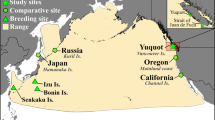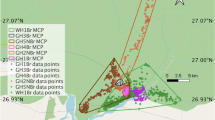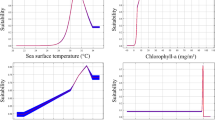Abstract
The study of animal foraging behaviour is of practical ecological importance1, and exemplifies the wider scientific problem of optimizing search strategies2. Lévy flights are random walks, the step lengths of which come from probability distributions with heavy power-law tails3,4, such that clusters of short steps are connected by rare long steps. Lévy flights display fractal properties, have no typical scale, and occur in physical3,4,5 and chemical6 systems. An attempt to demonstrate their existence in a natural biological system presented evidence that wandering albatrosses perform Lévy flights when searching for prey on the ocean surface7. This well known finding2,4,8,9 was followed by similar inferences about the search strategies of deer10 and bumblebees10. These pioneering studies have triggered much theoretical work in physics (for example, refs 11, 12), as well as empirical ecological analyses regarding reindeer13, microzooplankton14, grey seals15, spider monkeys16 and fishing boats17. Here we analyse a new, high-resolution data set of wandering albatross flights, and find no evidence for Lévy flight behaviour. Instead we find that flight times are gamma distributed, with an exponential decay for the longest flights. We re-analyse the original albatross data7 using additional information, and conclude that the extremely long flights, essential for demonstrating Lévy flight behaviour, were spurious. Furthermore, we propose a widely applicable method to test for power-law distributions using likelihood18 and Akaike weights19,20. We apply this to the four original deer and bumblebee data sets10, finding that none exhibits evidence of Lévy flights, and that the original graphical approach10 is insufficient. Such a graphical approach has been adopted to conclude Lévy flight movement for other organisms13,14,15,16,17, and to propose Lévy flight analysis as a potential real-time ecosystem monitoring tool17. Our results question the strength of the empirical evidence for biological Lévy flights.
This is a preview of subscription content, access via your institution
Access options
Subscribe to this journal
Receive 51 print issues and online access
$199.00 per year
only $3.90 per issue
Buy this article
- Purchase on Springer Link
- Instant access to full article PDF
Prices may be subject to local taxes which are calculated during checkout




Similar content being viewed by others
References
Turchin, P. Quantitative Analysis of Movement: Measuring and Modeling Population Redistribution in Animals and Plants (Sinauer, Sunderland, Massachusetts, 1998)
Shlesinger, M. F. Search research. Nature 443, 281–282 (2006)
Shlesinger, M. F., Zaslavsky, G. M. & Frisch, U. Lévy Flights and Related Topics in Physics (Springer, Berlin, 1995)
ben-Avraham, D. & Havlin, S. Diffusion and Reactions in Fractals and Disordered Systems (Cambridge Univ. Press, Cambridge, 2000)
Bardou, F., Bouchaud, J.-P., Aspect, A. & Cohen-Tannoudji, C. Lévy Statistics and Laser Cooling: How Rare Events Bring Atoms to Rest (Cambridge Univ. Press, Cambridge, 2002)
Ott, A., Bouchaud, J. P., Langevin, D. & Urbach, W. Anomalous diffusion in “living polymers”: a genuine Lévy flight? Phys. Rev. Lett. 65, 2201–2204 (1990)
Viswanathan, G. M. et al. Lévy flight search patterns of wandering albatrosses. Nature 381, 413–415 (1996)
Metzler, R. & Klafter, J. The restaurant at the end of the random walk: recent developments in the description of anomalous transport by fractional dynamics. J. Phys. A: Math. Gen. 37, R161–R208 (2004)
Klafter, J. & Sokolov, I. M. Anomalous diffusion spreads its wings. Phys. World 18, 29–32 (2005)
Viswanathan, G. M. et al. Optimizing the success of random searches. Nature 401, 911–914 (1999)
Reynolds, A. M. Scale-free movement patterns arising from olfactory-driven foraging. Phys. Rev. E 72, 041928 (2005)
Bénichou, O., Loverdo, C., Moreau, M. & Voituriez, R. Two-dimensional intermittent search processes: An alternative to Lévy flight strategies. Phys. Rev. E 74, 020102(R) (2006)
Mårell, A., Ball, J. P. & Hofgaard, A. Foraging and movement paths of female reindeer: insights from fractal analysis, correlated random walks, and Lévy flights. Can. J. Zool. 80, 854–865 (2002)
Bartumeus, F., Peters, F., Pueyo, S., Marrasé, C. & Catalan, J. Helical Lévy walks: Adjusting searching statistics to resource availability in microzooplankton. Proc. Natl Acad. Sci. USA 100, 12771–12775 (2003)
Austin, D., Bowen, W. D. & McMillan, J. I. Intraspecific variation in movement patterns: modeling individual behaviour in a large marine predator. Oikos 105, 15–30 (2004)
Ramos-Fernández, G. et al. Lévy walk patterns in the foraging movements of spider monkeys (Ateles geoffroyi). Behav. Ecol. Sociobiol. 55, 223–230 (2004)
Bertrand, S., Burgos, J. M., Gerlotto, F. & Atiquipa, J. Lévy trajectories of Peruvian purse-seiners as an indicator of the spatial distribution of anchovy (Engraulis ringens). ICES J. Mar. Sci. 62, 477–482 (2005)
Hilborn, R. & Mangel, M. The Ecological Detective: Confronting Models with Data (Vol. 28, Monographs in Population Biology, Princeton Univ. Press, New Jersey, 1997)
Burnham, K. P. & Anderson, D. R. Model Selection and Multimodel Inference: A Practical Information-Theoretic Approach 2nd edn (Springer, New York, 2002)
Johnson, J. B. & Omland, K. S. Model selection in ecology and evolution. Trends Ecol. Evol. 19, 101–108 (2004)
Afanasyev, V. A miniature storing activity recorder for seabird species with 80 bytes of memory for data storage. NERC Tech. 1, 4–7 (1993)
Shlesinger, M. F. & Klafter, J. Lévy walks versus Lévy flights. In On Growth and Form: Fractal and Non-Fractal Patterns in Physics (eds Stanley, H. E. & Ostrowsky, N.) 279–283 (Martinus Nijhoff Publishers, Dordrecht, 1986)
Newman, M. E. J. Power laws, Pareto distributions and Zipf’s law. Contemp. Phys. 46, 323–351 (2005)
Sims, D. W., Righton, D. R. & Pitchford, J. W. Minimizing errors in identifying Lévy flight behaviour of organisms. J. Anim. Ecol. 76, 222–229 (2007)
Pueyo, S. & Jovani, R. Comment on “A keystone mutualism drives pattern in a power function”. Science 313, 1739c (2006)
Weimerskirch, H., Gault, A. & Cherel, Y. Prey distribution and patchiness: factors in foraging success and efficiency of wandering albatrosses. Ecology 86, 2611–2622 (2005)
Focardi, S., Marcellini, P. & Montanaro, P. Do ungulates exhibit a food density threshold? A field study of optimal foraging and movement patterns. J. Anim. Ecol. 65, 606–620 (1996)
Heinrich, B. Resource heterogeneity and patterns of movement in foraging bumblebees. Oecologia 40, 235–245 (1979)
Sokal, R. R. & Rohlf, F. J. Biometry: The Principles and Practice of Statistics in Biological Research 3rd edn (W. H. Freeman and Company, New York, 1995)
Pueyo, S. Diversity: between neutrality and structure. Oikos 112, 392–405 (2006)
Acknowledgements
We thank P. Rothery, W. Blanchard and L. Thomas for statistical advice, and R. Myers, I. Jonsen, G. Breed, S.-J. Dunn, F. de Moura, J. Cressoni and M. Lyra for discussions. We acknowledge the work by all fieldworkers involved, in particular thanking B. Phalan and I. Forster for deploying devices at Bird Island. We thank M. Francis, A. Fukuda and H. Higuchi for providing instruments used in 2004, and J. Croxall for supporting albatross research at Bird Island. This work was funded by the UK Natural Environment Research Council and the Brazilian research agency CNPq. The work at the British Antarctic Survey represents a collaboration between the Discovery 2010 and Natural Complexity Programmes, and we appreciate P. Trathan’s efforts in facilitating it.
Author Contributions A.M.E. performed the analyses, computations and derivations presented in this paper, and led its preparation with input from all authors. The paper presents a synthesis of the work of two different teams of researchers who independently and concurrently conceived of re-examining the Lévy flight hypothesis with newer albatross data. One team (A) comprised N.W.W., M.P.F. and E.J.M. and was subsequently joined by A.M.E. The other team (B) comprised V.A., S.V.B., M.G.E.dL., E.P.R., H.E.S. and G.M.V.; R.A.P. provided albatross expertise to both teams. Team B were the first to show the implication of the long first and last dry sequences on the power-law distribution of albatross flight durations.
Author information
Authors and Affiliations
Corresponding author
Ethics declarations
Competing interests
The authors declare no competing financial interests.
Supplementary information
Supplementary Information
The file contains extensive Supplementary Methods, Supplementary Tables 1-2 and Supplementary Figures 1-6 with Legends. (PDF 4331 kb)
Rights and permissions
About this article
Cite this article
Edwards, A., Phillips, R., Watkins, N. et al. Revisiting Lévy flight search patterns of wandering albatrosses, bumblebees and deer. Nature 449, 1044–1048 (2007). https://doi.org/10.1038/nature06199
Received:
Accepted:
Issue Date:
DOI: https://doi.org/10.1038/nature06199
This article is cited by
-
Rafting behaviour of albatrosses and petrels at South Georgia
Polar Biology (2023)
-
Extreme Statistics of Superdiffusive Lévy Flights and Every Other Lévy Subordinate Brownian Motion
Journal of Nonlinear Science (2023)
-
Multiple Strategies Boosted Orca Predation Algorithm for Engineering Optimization Problems
International Journal of Computational Intelligence Systems (2023)
-
Modelling the dynamic relationship between spread of infection and observed crowd movement patterns at large scale events
Scientific Reports (2022)
-
Deconstructing and contextualizing foraging behavior in bumble bees and other central place foragers
Apidologie (2022)
Comments
By submitting a comment you agree to abide by our Terms and Community Guidelines. If you find something abusive or that does not comply with our terms or guidelines please flag it as inappropriate.



